AMD Kaveri Review: A8-7600 and A10-7850K Tested
by Ian Cutress & Rahul Garg on January 14, 2014 8:00 AM ESTIntegrated GPU Performance: BioShock Infinite
The first benchmark in our test is Bioshock Infinite, Zero Punctuation’s Game of the Year for 2013. Bioshock Infinite uses the Unreal Engine 3, and is designed to scale with both cores and graphical prowess. We test the benchmark using the Adrenaline benchmark tool and their three default settings of Performance (1280x1024, Low), Quality (1680x1050, Medium/High) and Xtreme (1920x1080, Maximum) noting down the average frame rates and the minimum frame rates.
Bioshock Infinite, Performance Settings
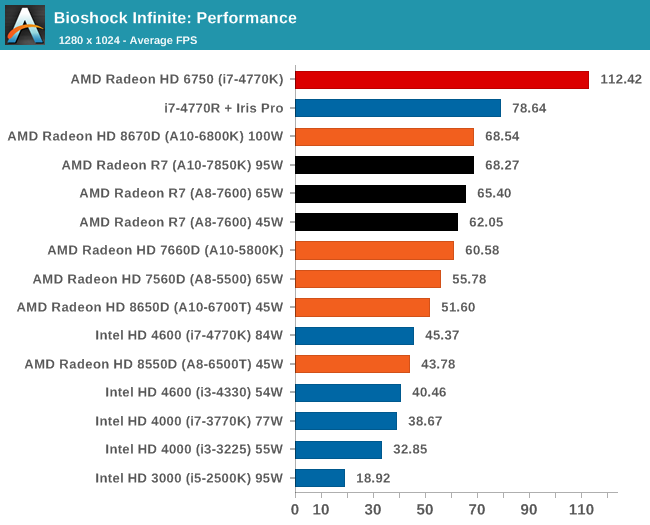
For BI: Performance we see the Iris Pro being top of the IGPs, although the next six in the list are all AMD. The Kaveri cores are all between the 6800K and 5800K for this test, and all comfortably above 60 FPS average.
Bioshock Infinite, Quality Settings

For the quality settings, the Iris Pro starts to struggle and all the R7 based Kaveri APUs jump ahead of the A10-6800K - the top two over the Iris Pro as well.
Bioshock Infinite, Xtreme Settings
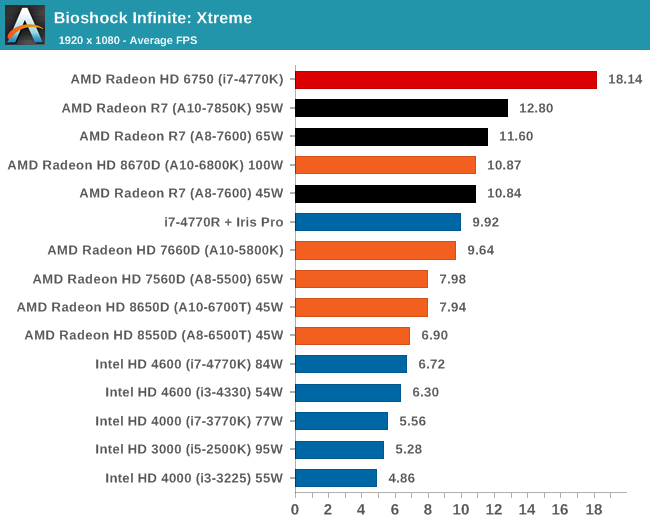
The bigger the resolution, the more the Iris Pro suffers, and Kaveri takes three out of the top four IGP results.
Integrated GPU Performance: Tomb Raider
The second benchmark in our test is Tomb Raider. Tomb Raider is an AMD optimized game, lauded for its use of TressFX creating dynamic hair to increase the immersion in game. Tomb Raider uses a modified version of the Crystal Engine, and enjoys raw horsepower. We test the benchmark using the Adrenaline benchmark tool and their three default settings of Performance (1280x1024, Low), Quality (1680x1050, Medium/High) and Xtreme (1920x1080, Maximum) noting down the average frame rates and the minimum frame rates.
Tomb Raider, Performance Settings
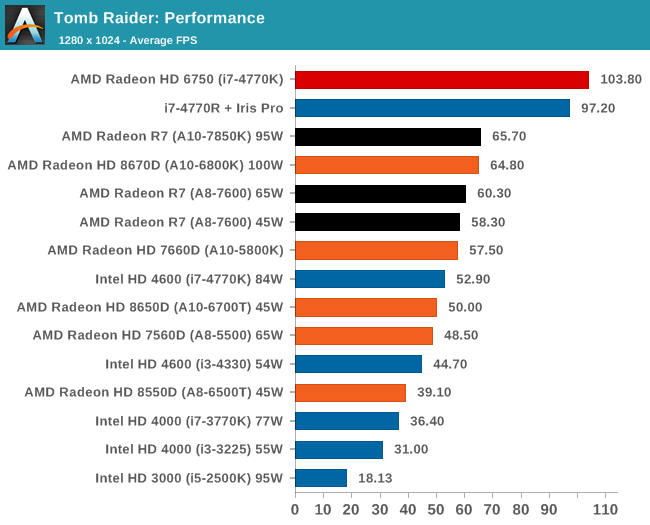
The top IGP for Richland and Kaveri are trading blows in TR.
Tomb Raider, Quality Settings

The Iris Pro takes a small lead, while the Kaveri 95W APU show little improvement over Richland. The 45W APU however is pushing ahead.
Tomb Raider, Xtreme Settings
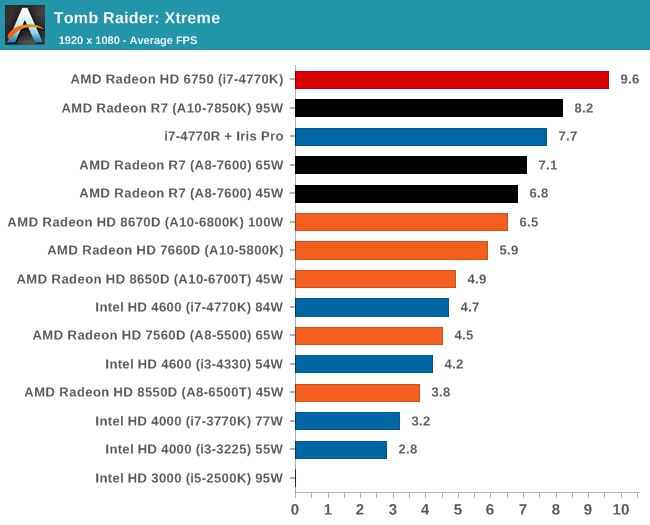
At the maximum resolution, the top Kaveri overtakes Iris Pro, and the 45W Kaveri it still a good margin ahead of the A10-6700T.
Integrated GPU Performance: F1 2013
Next up is F1 2013 by Codemasters. I am a big Formula 1 fan in my spare time, and nothing makes me happier than carving up the field in a Caterham, waving to the Red Bulls as I drive by (because I play on easy and take shortcuts). F1 2013 uses the EGO Engine, and like other Codemasters games ends up being very playable on old hardware quite easily. In order to beef up the benchmark a bit, we devised the following scenario for the benchmark mode: one lap of Spa-Francorchamps in the heavy wet, the benchmark follows Jenson Button in the McLaren who starts on the grid in 22nd place, with the field made up of 11 Williams cars, 5 Marussia and 5 Caterham in that order. This puts emphasis on the CPU to handle the AI in the wet, and allows for a good amount of overtaking during the automated benchmark. We test at three different levels again: 1280x1024 on Low, 1680x1050 on Medium and 1920x1080 on Ultra. Unfortunately due to various circumstances we do not have Iris Pro data for F1 2013.
F1 2013, Performance Settings
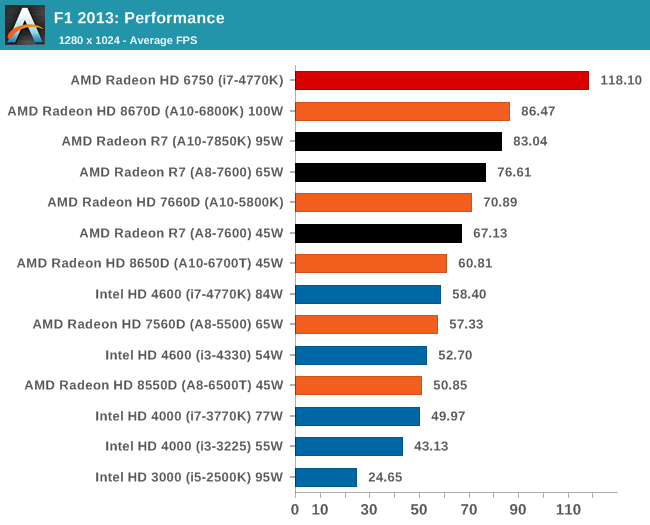
F1 likes AMD here, although moving from Kaveri to Richland at the high end seems a bit of a regression.
F1 2013, Quality Settings
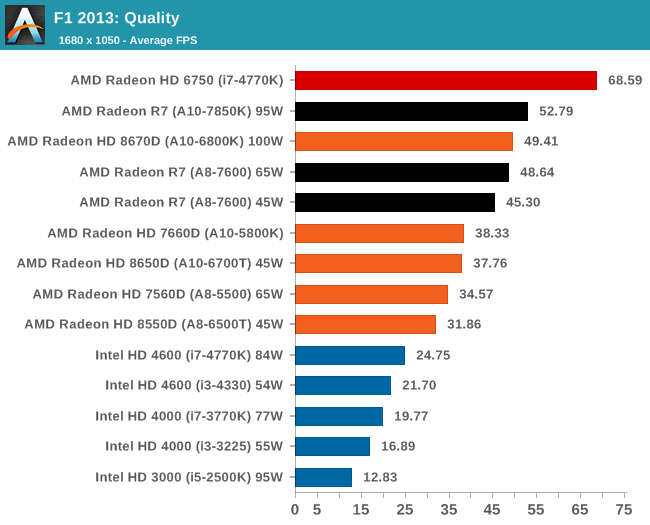
Similarly in the Quality settings, none of the Intel integrated graphics solutions can keep up with AMD, especially Kaveri.
F1 2013, Xtreme Settings

On extreme settings, at 1080p, the top Kaveri APU manages to hit over 30 FPS average during the benchmark. The other A8 Kaveri data is not too far behind.










380 Comments
View All Comments
Nagorak - Wednesday, January 15, 2014 - link
The fact is these "APUs" are really pretty worthless. If you're going to be seriously gaming then you want to get a discrete graphics card, even a low end one. The problem with AMD's strategy here is that the integrated GPU performance is still so anemic that it's only useful for people who want a budget PC and who don't actually play games. Therefore the "benefits" of having both CPU and GPU on one core are highly questionable.ImSpartacus - Thursday, January 16, 2014 - link
That could be solved if we had a much larger GPU on the APU, right?I want to see at least 12 CUs on the top-end APU, preferably more like 16-20 CUs.
lmcd - Monday, January 20, 2014 - link
Did you miss the whole conversation about memory bandwidth?nader_21007 - Saturday, January 18, 2014 - link
below the charts showing the games performanc, there are two tabs, one for showing avarage frame rate and the other, if you just click on it will show you the suddeframe rates for the apus compared. Minimum frame rate of the iris pro is the lowest and worst among all Apu's compared. It means sudden hangings all over the game. Kaveri and other amd apu's have no such weaknesses because of high performing IGP.Now tell me which is Outperformed?themeinme75 - Saturday, January 18, 2014 - link
the good news is APU-7850/SOC-5200pro just caught up to 4850..cryptik - Monday, March 30, 2015 - link
The R7 consistently beats the Iris Pro. You must have read a different article than everyone else.frozentundra123456 - Tuesday, January 14, 2014 - link
Good review, except he doesn't really address the elephant in the room that even for gaming, a low end cpu like the athlon X4 with a HD7750 will be considerably faster than any APU. So in this regard, I disagree with the conclusions that for low end gaming kaveri is the best solution. It is disappointing actually, that he did not use a HD7750 GDDR5 as the discrete gpu comparison, because that would have given a more direct comparison of how the bandwidth restrictions are affecting Kaveri.I will say though that the low TDP parts seem to get a nice improvement in performance. They actually seem more attractive that the high end, since there is little gaming improvement in the top end vs Richland.
thevoiceofreason - Tuesday, January 14, 2014 - link
Or something like Pentium G2120 (90$ newegg) and HD7770 (90$ ASUS or MSI on newegg after rebate). The difference between such a setup and a top of the line kaveri chip is not even funny. Kind of tragic, really.andrewaggb - Tuesday, January 14, 2014 - link
I agree. I am extremely dissappointed. Cpu performance and GPU performance barely changed from last year's model. HSA is definitely the future, and Mantle may deliver a healthy fps improvement, but I feel like this product has almost no value at launch. It's all depending on future software.I was actually considering a kaveri for a kids pc... but I'm definitely way better off getting an intel cpu and amd gpu.
andrewaggb - Tuesday, January 14, 2014 - link
I guess they did make big gains on TDP. So it's sorta their version of a haswell refresh. But haswell had a larger improvement in both cpu and gpu performance relative to their previous chip.